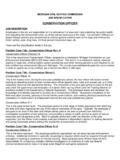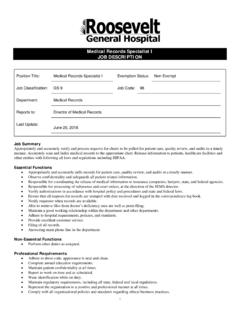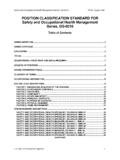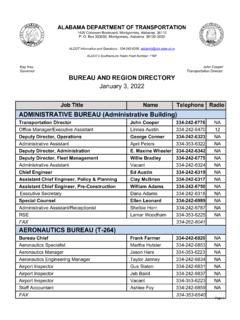Transcription of Legionella Environmental Assessment Form (LEAF)
1 Centers for Disease Control and PreventionLegionella Environmental Assessment Form HOW TO USE THIS FORMThis form enables public health officials to gain a thorough understanding of a facility s water systems and aerosolizing devices and assists facility management with minimizing the risk of Legionnaires disease. It can be used along with epidemiologic information to determine whether to conduct Legionella Environmental sampling and to develop a sampling plan. In addition, findings from this Environmental Assessment can be used to develop a water management program (WMP) by identifying areas at risk for Legionella growth and spread.
2 The Assessment should be performed on site by an epidemiologist or Environmental health specialist with knowledge of the ecology of Legionella , building water systems, and water treatment; this includes public health professionals familiar with CDC resources such as the Legionella Environmental Assessment Form Marking Guide, Toolkit for Controlling Legionella in Common Sources of Exposure, and LEAF Marking Guide walks the user through this form by providing instructions and additional considerations for the questions by adding further context and discussing relevant risk factors for Legionella growth and spread that users may find the form in as much detail as possible.
3 The content in the Facility Characteristics and Water Supply Source sections will be applicable to every Assessment . Do not leave questions blank; if a question does not apply, write N/A. If a question applies but cannot be answered, explain why. Where applicable, specify the units of measurement being used ( , ppm). Take pictures and attach them to the form to visually support the written findings. Pictures should be taken of any significant findings in implicated mechanical components and water treatment systems. It may take several hours to complete the the device-specific appendices that pertain to the facility being assessed after completing the relevant portions of the main form.
4 Keep the following key factors that contribute to Legionella growth in mind as you complete the form: *Sediment and Biofilm Mineral buildup in a system supports Legionella growth and consumes disinfectant residual. Microorganisms and the slime they secrete make up biofilms that stick to and grow on any continually moist surface. Biofilms provide a stable growth surface and an environment with nutrients for many types of germs, including Legionella . *Temperature Legionella generally grow well between 77 F and 113 F. The optimal growth range for Legionella is between 85 F and 108 F.
5 Growth slows between 113 F and 120 F, and Legionella begin to die above 120 F. Growth also slows between 68 F and 77 F, and Legionella become dormant below 68 F. *Water Age Slowly moving or stagnant water increases water age, which provides opportunities for Legionella growth. Higher water age also contributes to disinfectant residual loss and favorable temperatures for growth. *Disinfectant Residual Disinfectant residuals are the amount of chemical disinfectant available in the water to inhibit Legionella growth. Disinfectant residual decreases as water age and temperature increase.
6 Refer to CDC s Legionella Control Toolkit for detailed guidance on evaluating the key factors for Legionella growth in specific water systems and devices. For additional training and information, please see CDC s resources for health departments. 03/07/2022 CS328976-A PRINT ONLYSAFETY PRECAUTIONSIf the epidemiologic information available suggests a device is a potential source ( , hot tub, cooling tower), request that the facility management turn it off (but do not drain or disinfect) to stop transmission. Persons at increased risk of developing Legionnaires disease if exposed to Legionella ( , immunocompromised individuals) should not accompany the sampling Personal Protective Equipment (PPE)Gloves are useful for sampling hot tub filters or other sites that may be heavily contaminated with organic a half-face air-purifying respirator equipped with an N95 filter may be appropriate in the following situations: a.
7 When sampling cooling towers if the fans cannot be turned off, or b. in enclosed spaces with an aerosol-generating device that cannot be turned off. Respirators must be used in accordance with a comprehensive respiratory protection program, which includes fit testing, training, and medical clearance ahead of their use (see OSHA standard 29 CFR ). For more information about N95 respirators, visit the National Institute for Occupational Safety and Health (NIOSH) ARRIVING ON SITE Request the attendance of the lead facility manager as well as others who have a detailed knowledge of the facility s water systems, such as a facility engineer or industrial hygienist.
8 Request that they have maintenance logs and facility construction as-built diagrams available for the meeting. Bring a plastic 500ml or 1L bottle for water parameter sampling, thermometer, pH test kit, and a colorimeter that can detect a wide range of residual disinfectant (<1 ppm for potable water and up to 10 ppm for hot tub water).3 | CDC Legionella Environmental Assessment Form | Environmental Assessment FORMP erson(s) completing the Assessment :Name: _____ Job Title: _____ Organization: _____Telephone: _____ E-mail: _____Name: _____ Job Title: _____ Organization: _____Telephone: _____ E-mail: _____Assessment details:Facility Name: _____ Date of Assessment : _____Facility Address.
9 _____ street city state zipPerson(s) interviewed during the Assessment :Name: _____ Job Title: _____ Organization: _____Telephone: _____ E-mail: _____Name: _____ Job Title: _____ Organization: _____Telephone: _____ E-mail: _____Name: _____ Job Title: _____ Organization: _____Telephone: _____ E-mail: _____Date of Environmental Assessment : _____Facility Characteristics1. Is this a healthcare facility or facility with skilled nursing care ( , hospital, long term care/rehab/skilled nursing facility, clinic), or an assisted or senior living facility?
10 YES If YES, skip to Question 2 and also complete Appendix A. NOIf NO, indicate type of facility (check all that apply): Other residential building ( , apartment, condominium) Hotel, motel, or resort Vacation rental property ( , Airbnb, VRBO, Vacasa) Recreational facility ( , health club, water park) Office building Manufacturing facility Restaurant Other _____4 | CDC Legionella Environmental Assessment Form | Total number of buildings on the premises: _____ Total number of buildings being assessed: _____3. Total number of rooms that can be occupied overnight ( , patient rooms, hotel rooms): _____ 4.

















